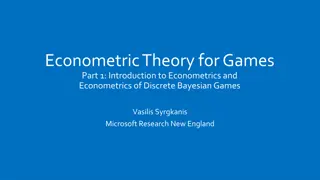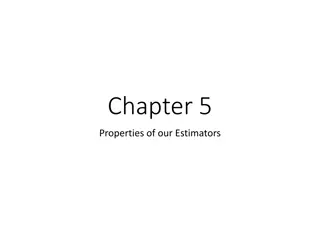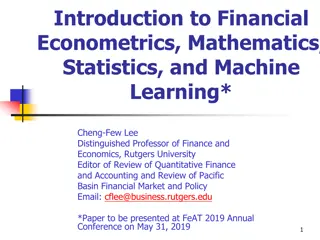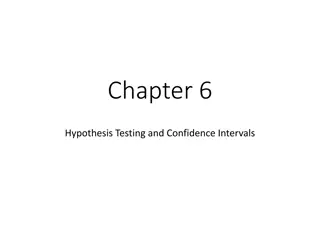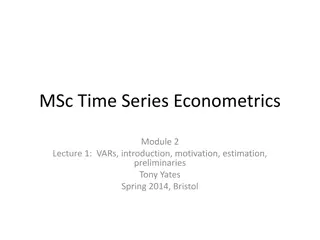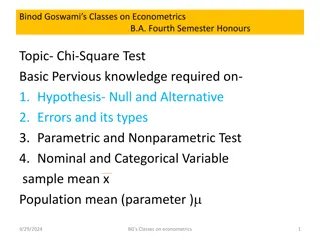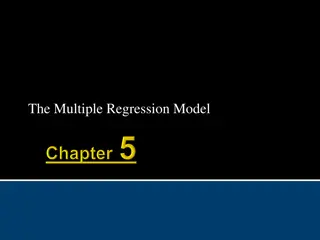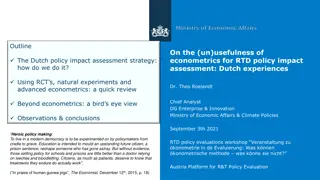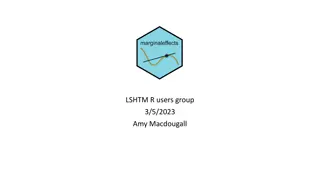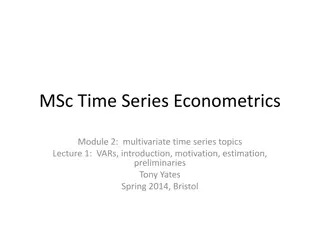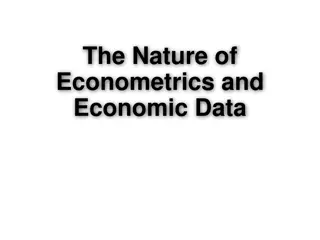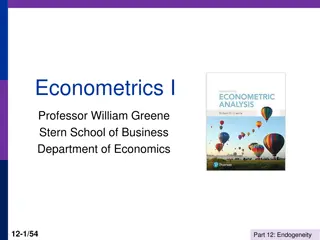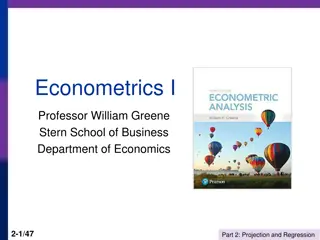
Functional Form in Econometrics: Dummy Variables, Regression Analysis, and Art Sales Analysis
Explore the concept of functional form in econometrics through discussions on dummy variables, regression analysis, and analysis of art sales data involving Monet paintings. Understand how variables interact, examine different forms of regression, and delve into the dynamics of art pricing. Additionally, discover a conspiracy theory related to art sales at prestigious auction houses.
Download Presentation

Please find below an Image/Link to download the presentation.
The content on the website is provided AS IS for your information and personal use only. It may not be sold, licensed, or shared on other websites without obtaining consent from the author. If you encounter any issues during the download, it is possible that the publisher has removed the file from their server.
You are allowed to download the files provided on this website for personal or commercial use, subject to the condition that they are used lawfully. All files are the property of their respective owners.
The content on the website is provided AS IS for your information and personal use only. It may not be sold, licensed, or shared on other websites without obtaining consent from the author.
E N D
Presentation Transcript
Econometrics I Professor William Greene Stern School of Business Department of Economics 6-1/41 Part 6: Functional Form
Econometrics I Part 6 Dummy Variables and Functional Form 6-2/41 Part 6: Functional Form
Agenda Dummy variables Interaction Categorical variables and transition tables Nonlinear functional form Differences Difference in differences Regression discontinuity Kinked regression 6-3/41 Part 6: Functional Form
Monet in Large and Small Sale prices of 328 signed Monet paintings Fitted Line Plot ln (US$) = 2.825 + 1.725 ln (SurfaceArea) 18 S R-Sq R-Sq(adj) 1.00645 20.0% 19.8% 17 16 15 ln (US$) 14 13 12 11 6.0 6.2 6.4 6.6 6.8 7.0 7.2 7.4 7.6 ln (SurfaceArea) Log of $price = a + b log surface area + e 6-4/41 Part 6: Functional Form
How Much for the Signature? The sample also contains 102 unsigned paintings Average Sale Price Signed $3,364,248 Not signed $1,832,712 Average price of a signed Monet is almost twice that of an unsigned one. 6-5/41 Part 6: Functional Form
A Multiple Regression Scatterplot of ln (US$) vs ln (SurfaceArea) 18 Signed 0 1 17 16 d 15 ln (US$) 14 13 12 11 10 6.0 6.2 6.4 6.6 6.8 7.0 7.2 7.4 7.6 ln (SurfaceArea) Ln Price = a + b ln Area + d (0 if unsigned, 1 if signed) + e 6-6/41 Part 6: Functional Form
Monet Multiple Regression Regression Analysis: ln (US$) versus ln (SurfaceArea), Signed The regression equation is ln (US$) = 4.12 + 1.35 ln (SurfaceArea) + 1.26 Signed Predictor Coef SE Coef T P Constant 4.1222 0.5585 7.38 0.000 ln (SurfaceArea) 1.3458 0.08151 16.51 0.000 Signed 1.2618 0.1249 10.11 0.000 S = 0.992509 R-Sq = 46.2% R-Sq(adj) = 46.0% Interpretation: (1) Elasticity of price with respect to surface area is 1.3458 very large (2) The signature multiplies the price of a painting by exp(1.2618) (about 3.5), for any given size. 6-7/41 Part 6: Functional Form
A Conspiracy Theory for Art Sales at Auction Sotheby s and Christies, 1995 to about 2000 conspired on commission rates. 6-8/41 Part 6: Functional Form
If the Theory is Correct Scatterplot of ln (US$) vs ln (SurfaceArea) 18 Sold from 1995 to 2000 17 16 Sold before 1995 or after 2000 15 14 ln (US$) 13 12 11 10 9 3 4 5 6 7 8 9 ln (SurfaceArea) 6-9/41 Part 6: Functional Form
Evidence The statistical evidence seems to be consistent with the theory. Effects on Price Not 1995-2000 1995-2000 Unsigned Signed exp(0.0000)=1.0000 exp(0.2009)=1.2225 exp(1.2777)=3.5884 exp(1.2777+0.2009)=4.3868 6-10/41 Part 6: Functional Form
Women appear to assess health satisfaction differently from men. 6-11/41 Part 6: Functional Form
Or do they? Not when other things are held constant 6-12/41 Part 6: Functional Form
Dummy Variable for One Observation A dummy variable that isolates a single observation. What does this do? Define d to be the dummy variable in question. Z = all other regressors. X = [Z,d] Multiple regression of y on X. We know that X'e = 0 where e = the column vector of residuals. That means d'e = 0, which says that ej = 0 for that particular residual. The observation will be predicted perfectly. Fairly important result. Important to know. 6-13/41 Part 6: Functional Form
I have a simple question for you. Yesterday, I was estimating a regional production function with yearly dummies. The coefficients of the dummies are usually interpreted as a measure of technical change with respect to the base year (excluded dummy variable). However, I felt that it could be more interesting to redefine the dummy variables in such a way that the coefficient could measure technical change from one year to the next. You could get the same result by subtracting two coefficients in the original regression but you would have to compute the standard error of the difference if you want to do inference. Is this a well known procedure? YES 6-14/41 Part 6: Functional Form
6-15/41 Part 6: Functional Form
Example with 4 Periods The estimated model with time dummies is y = a +b2*d2+ b3*d3 + b4*d4 + e (possibly some other variables, not needed now). Estimated least squares coefficients are b = a, b2, b3, b4 Desired coefficients are c = a, b2, b3 b2, b4 b3 The original model is y = Xb + e. The new model would be y = (XC)(C-1b) + e = Qc + e The transformation of the data is Q = XC. c = C-1b The transformed X is [1,d2+d3+d4, d3+d4.d4] 1 0 0 0 0 1 0 0 1 0 0 0 1 0 0 0 0 1 1 1 0 0 1 1 0 0 0 1 = = 1 C C , 1 0 1 1 6-16/41 Part 6: Functional Form
A Categorical Variable 6-17/41 Part 6: Functional Form
6-18/41 Part 6: Functional Form
Nonlinear Specification: Quadratic Effect of Experience 6-19/41 Part 6: Functional Form
Model Implication: Effect of Experience and Male vs. Female 6-20/41 Part 6: Functional Form
Partial Effect of Experience: Coefficients do not tell the story Education: .05654 Experience: .04045 - 2*.00068*Exp FEM: -.38922 6-21/41 Part 6: Functional Form
Effect of Experience = .04045 - 2 * 0.00068*Exp Positive from 1 to 30, negative after. 6-22/41 Part 6: Functional Form
Specification and Functional Form: Nonlinearity Population Estimators = + + + + = + b x b x + + 2 2 y y x x z b b z 1 2 3 4 1 2 3 4 [ | , ] E y x z x = = = + + 2 2 x b b x 2 3 2 3 x x 6-23/41 Part 6: Functional Form
Log Income Equation ---------------------------------------------------------------------- Ordinary least squares regression ............ LHS=LOGY Mean = -1.15746 Estimated Cov[b1,b2] Standard deviation = .49149 Number of observs. = 27322 Model size Parameters = 7 Degrees of freedom = 27315 Residuals Sum of squares = 5462.03686 Standard error of e = .44717 Fit R-squared = .17237 --------+------------------------------------------------------------- Variable| Coefficient Standard Error b/St.Er. P[|Z|>z] Mean of X --------+------------------------------------------------------------- AGE| .06225*** .00213 29.189 .0000 43.5272 AGESQ| -.00074*** .242482D-04 -30.576 .0000 2022.99 Constant| -3.19130*** .04567 -69.884 .0000 MARRIED| .32153*** .00703 45.767 .0000 .75869 HHKIDS| -.11134*** .00655 -17.002 .0000 .40272 FEMALE| -.00491 .00552 -.889 .3739 .47881 EDUC| .05542*** .00120 46.050 .0000 11.3202 --------+------------------------------------------------------------- Average Age = 43.5272. Estimated Partial effect = .066225 2(.00074)43.5272 = .00018. Estimated Variance 4.54799e-6 + 4(43.5272)2(5.87973e-10) + 4(43.5272)(-5.1285e-8) = 7.4755086e-08. Estimated standard error = .00027341. 6-24/41 Part 6: Functional Form
Objective: Impact of Education on (log) Wage Specification: What is the right model to use to analyze this association? Estimation Inference Analysis 6-25/41 Part 6: Functional Form
Application: Is there a relationship between (log) Wage and Education? 6-26/41 Part 6: Functional Form
Group (Conditional) Means (Nonparametric) 6-27/41 Part 6: Functional Form
Simple Linear Regression (semiparametric) LWAGE = 5.8388 + 0.0652*ED 6-28/41 Part 6: Functional Form
Multiple Regression 6-29/41 Part 6: Functional Form
Interaction Effect Gender Difference in Partial Effects 6-30/41 Part 6: Functional Form
Partial Effect of a Year of Education E[logWage]/ ED= ED + ED*FEM *FEM Note, the effect is positive. Effect is larger for women. 6-31/41 Part 6: Functional Form
Gender Effect Varies by Years of Education -0.67961 is misleading 6-32/41 Part 6: Functional Form
Difference in Differences With two periods, i2 i1 Consider a "treatment, D ," that takes place between time 1 and time 2 for some of the individuals y = + ( ) + D + u D = the "treatment dummy" y = y -y = + ( x - x ) + u it i2 i1 0 i i x i 0 i 1 i i i This is a linear regression model. If there are no regressors, = y|treatment - y|control = "difference in differences" estimator. Average change in y for the "treated" = 1 0 i 6-33/41 Part 6: Functional Form
SAT Tests Using least squares, d (Score Potential = Income, Parents' Education, GPA x = Score ) (Score Score ) 2 1 2 1 = 3 TestPrep 1 TestPrep=0 6-34/41 Part 6: Functional Form
Difference-in-Differences Model With two periods and strict exogeneity of D and T, + 0 + + + y = D = dummy variable for a treatment that takes place between time 1 and time 2 for some of the individuals, T = a time period dummy variable, 0 in period 1, 1 in period 2. D T TD it 1 it 2 t 3 t it it it t This is a linear regression model. If there are no regressors, Using least squares, b (y = 1 D 1 y ) (y 1 D 0 y ) = = 3 2 2 6-35/41 Part 6: Functional Form
Difference in Differences + + + = + + + y |D + + + = y = D D D T ( ( D T it x , t 1,2 it y = 0 1 it 2 t 3 t it it = y |D + + u x ) ) 0 it 2 3 i 2 it it x 2 3 i 2 it i ( If the same individual is observed in both states the second term is zero. If the effect is estimated by averaging individuals with D = 1 and different individuals with D=0, then part of the 'effect' is explained by change in the covariates, not the treatment. ) ( ) = 1 it it = + = ( = ( x |D 1) x |D 0) 3 it it , 6-36/41 Part 6: Functional Form
Abrupt Effect on Regression at a Specific Level of x 6-37/41 Part 6: Functional Form
6-38/41 Part 6: Functional Form
Useful Functional Form: Kinked Regression 6-39/41 Part 6: Functional Form
6-40/41 Part 6: Functional Form
Kinked Regression and Policy Analysis: Unemployment Insurance 6-41/41 Part 6: Functional Form

